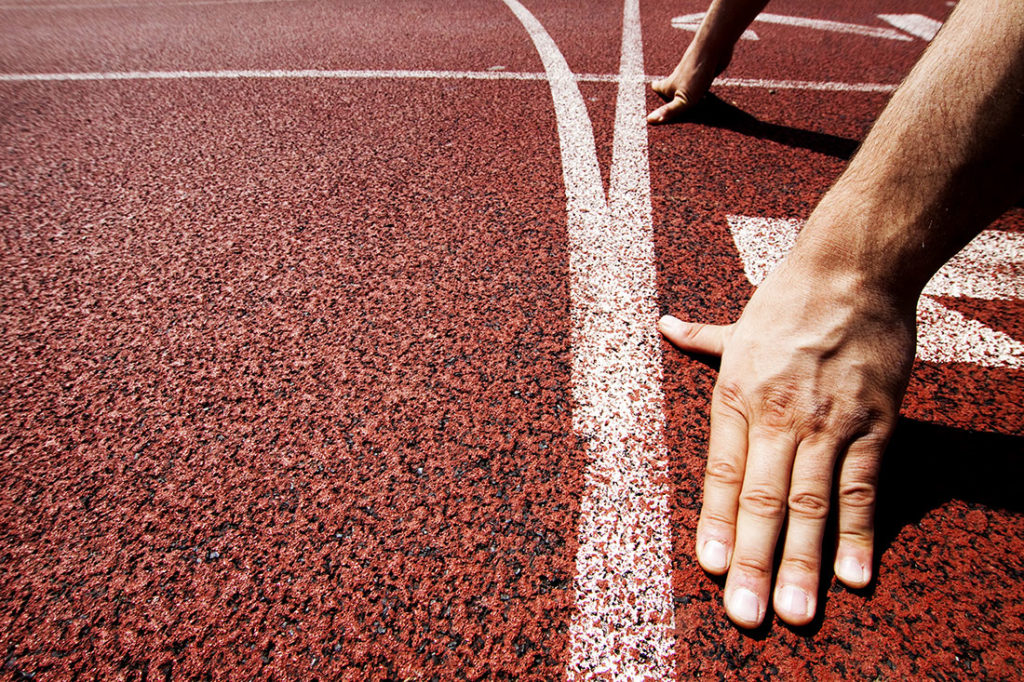This is the first installment in a series of stories tracking our writer Matt Crossman’s progress on improving his scores in the SAT for sports … if he makes any (and that’s a 40-yard tall IF).
I put my hand on the starting line and looked toward the end, 40 yards way. My eyes tightened with concentration, and a sense of anticipation tingled in my heart. And also foolishness. I was about to run a 40-yard dash for the first time in my life. Worse yet, I was going to time that 40-yard dash and tell the world, or at least people who read this diary, exactly how slow of a runner I am.
I lifted my hand off the ground, pushed off with my right foot and exploded out of my stance down the field.
HA!
Heck to the no!
I’m 48 years old! I haven’t exploded out of anything in decades!
Anyway, I raised out of my stance as quickly as I could. My legs carried me across the 10-yard mark in 2.14 seconds. I no longer felt foolish … or at least not as much. The coronavirus has overtaken all aspects of our lives. Running, if even for a few seconds, gave me a small bit of control for the first time in what seemed like months. I was outside, doing something, which felt good even if it was also ridiculous. It sure beat the alternative. I was not obsessively refreshing Twitter, I was not googling the latest baloney about the coronavirus, I was not mourning the loss of the future I had yearned for a few short weeks ago.
As life has become cloistered, I’ve asked myself: What can I do with the extra time that isn’t binging Netflix or working countless hours? What can I do that will separate me from the news and is also good for me physically, emotionally and spiritually? What can I do that will prevent the soft decline into a sedentary life? Can I find something that meets all of that and will also make me, and hopefully you, laugh?
The answer I came up with is all kinds of crackpot, and it’s why I ran the 40-yard dash: I am training to become an average high school athlete, 30 years after I graduated.
***
Mike Weinstein is an entrepreneur who owns a business called Zybek Sports. He has created the “SAT for sports,” a series of tests meant to measure a person’s athletic ability. The test comprises the 40-yard dash, high jump, broad jump and a couple agility drills.
Weinstein administered the test to 20,800 people last year, the vast majority of them high school students. At my request, he created graphs of the scores on each test. Last week, I ran the 40 to give myself a base from which to train. I’ll take the whole test in a month to gauge my progress and take it again for a final time two months from now.
For the sake of this series of diaries, I’m defining “average high school athlete” as broadly as possible: someone whose scores fall between the 25th percentile and the 75th percentile on Weinstein’s SAT. Anyone below 25th is a bad athlete, anybody above 75th is a good athlete, and everybody in between is average.
This unlikely quest becomes even unlikelier when I confess that even when I was in high school, I was not an average athlete. I played on the tennis team, and I’m not being immodest when I say I was terrible. I won less than 25% of my matches. I was slow and uncoordinated and folded at the first sign of pressure.
I spent most of my adult life lightly active. I played church softball and did cardio workouts a few times a week. In recent years, I’ve become an adventure writer, which requires a higher level of fitness. I keep myself in “just in case” shape. As in, just in case I sell a story that requires exertion, I can do it.
But this project scares me a little (by which I mean a lot). When I’ve trained for stories in the past, it’s always been for endurance, never for speed. I’m stubborn enough to keep going. But stubbornness won’t make me run faster or jump higher. I have never done any of the events in the test. The question is not whether I’ll make a fool of myself, it’s to what extent. Already, in a cliché come to life, I tweaked my hamstring.
***
Twice in three hours last week, friends told me they were “going stir crazy.” One of them was so bored he looked up the origin of the term. I was so bored I listened when he explained it to me. I’m approaching stir crazy myself. I am training for the SAT for sports to fight that.
My workout friends and I often engage in inconsequential tasks that exist only because they are difficult. We call them Completely Stupid and Utterly Pointless, which we have abbreviated to CSAUP and turned into a word that is pronounced see-sop. My attempt to become an average high school athlete is CSAUPBARI, or Completely Stupid and Utterly Pointless But Also Really Important.
I don’t mean my quest is important. I mean the idea behind it—to take steps to protect myself against succumbing to dread. While the numbers I eventually put up don’t matter, what I hope to accomplish through training for the test does matter. I care more about what I’m avoiding—anxiety, fear, depression, listless stupor—than any marginal improvements I might get. For the last few weeks, it seems like every decision, no matter how minor, carries impossible weight. I had to work up the guts to go inside the carryout Chinese place, hand the clerk my credit card, and then use his pen to sign the bill. There will be no room for fear when I’m running sprints alone.
My hope is to bring you along for the ride, to make you point at me and laugh, and also to encourage you, dare I say inspire you. I also hope you’ll come up with your own CSAUPBARI task. Maybe you’ll take piano lessons (my second choice), teach yourself to cook, learn to speak German or something even more whack-a-doodle than what I’m doing. Whatever you do, I hope you’ll find it as a release for the tension of being cooped up, I hope you’ll find an antidote for anxiety, and I hope you’ll laugh when nothing else seems funny.
I also hope you’ll find a way to do it with somebody who can hold you accountable, walk (metaphorically) alongside you, challenge you. Yes, we must keep physical distance from each other. But if we allow that physical distance to force us into relational distance, COVID-19 will live on far after the infections die down.
***
I invited another 40-something friend, an agriculture professor named Micah Humphreys, to take the SAT for sports and complete the training with me. And he’s just crazy enough to say yes. We will follow social distancing rules. We will mock each other’s poor performance relentlessly via phone, text, email, etc. Already he sent me slow motion video of me running the 40-yard dash, though it takes a discerning eye to recognize the distance between my actual speed and my slow-mo speed.
Two other characters will join us from afar. Ryan Roth is the owner of the St. Louis franchise of D1 Training, a nationwide network of gyms. His facility is a “testing center” for Weinstein’s SAT for sports, so he has the equipment needed to grade me. The gym itself is closed, of course. But he will be my virtual encourager. Trey Adams, who works for D1, will administer the test at a football field near my house and set me up with a training program that I can follow from home. He is considering joining Humphreys and me in the training; I would be far more supportive of that if he wasn’t 23 and in fantastic shape.
Can I become an average high school athlete 30 years later? After getting my time in the 40-yard dash—6.14 seconds—and comparing it to the 25th percentile score—5.95—I submit my answer with confidence: Maybe.
But who cares about that? I will try, and that’s the point.
Related: Try These 30-Day Challenges to Unlock Your Inner Greatness
Photo by Melinda Nagy/Shutterstock.com












